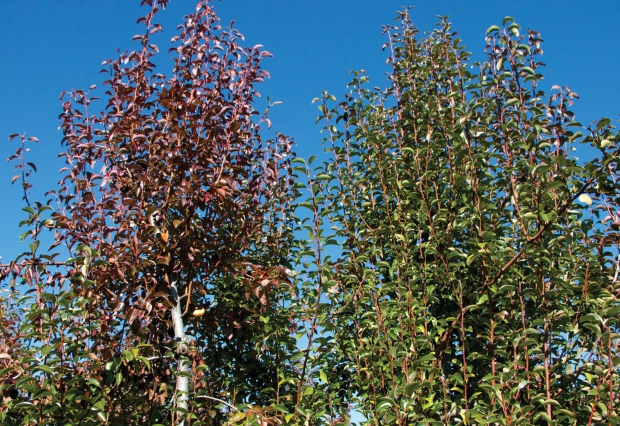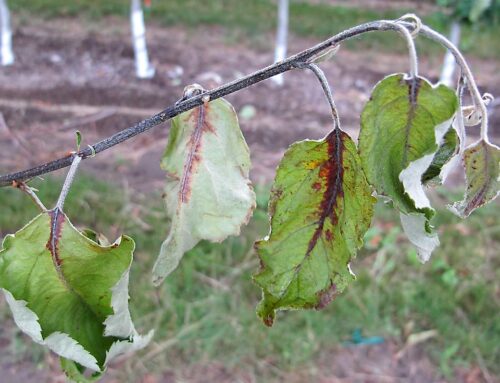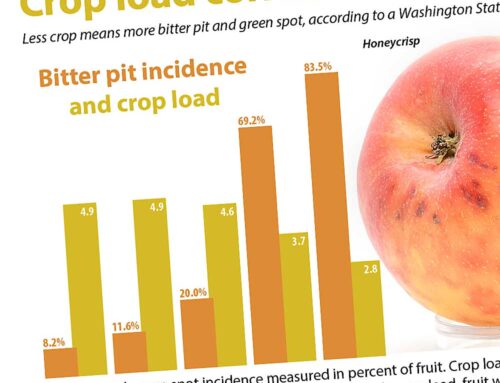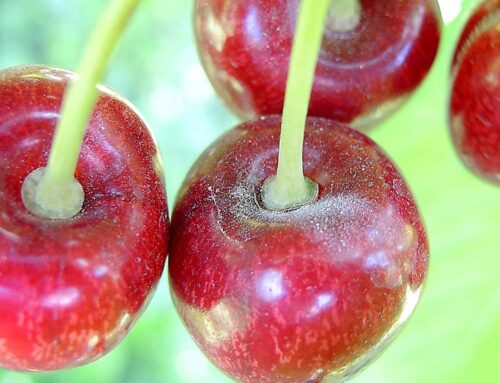
The federal government is spending hundreds of thousands of dollars for research into non-antibiotic controls for fire blight. (TJ Mullinax/Good Fruit Grower file photo)
Apple growers use two chemical tools to control fire blight: antibiotics to suppress growth of the bacterial pathogen Erwinia amylovora, in its blossom blight phase and also later in the season, and Apogee (prohexadione calcium) to slow down and toughen tender growth during the shoot blight infection phase.
Neither is available for use by organic apple growers. Apogee never was, and now antibiotics won’t be either, officially as of last fall. That’s going to make it tough for organic growers, especially those outside the desert climes of the West.
Instead, they will be left with control programs based on cultural methods (lots of pruning), copper materials, and several biological products, the best being Serenade Optimum, which is only 50 percent as effective as streptomycin, an antibiotic that provides conventional growers 90 to 95 percent control of fire blight, according to Dr. George Sundin, Michigan State University plant pathologist.
In Sudin’s tests of Serenade Optimum, which is used like streptomycin—sprayed on during blossom time—only 42 percent control was achieved.
Another material, Blossom-Protect, works well in the West, Sundin said, but has been inconsistent in the East, at least so far. Blossom-Protect is a yeast product. The concept is to spray it onto blossoms, where the yeast “pre-colonizes” sites on the flower stigma so they are not available for colonization by the fire blight bacteria.
Fire blight bacteria colonize the stigma then move down the style to the base of the flower, and the flower cluster becomes blighted and provides inoculum for shoot infections. The bacteria move with wind, water, and insects. Any event that causes tissue wounding—such as hail or high wind—provides infection opportunities for the blight.
Another material that can be used in organic production is Oxidate, the trade name for a hydrogen dioxide product. That oxidizer kills bacteria and also kills fungi, such as apple scab. But it oxidizes other tissue as well and can kill blossoms. That can be a good thing if thinning is desired.
Studies under way
The federal government, through its organic and specialty crop research funding mechanisms, has allocated hundreds of thousands of dollars for research to find non-antibiotic fire blight controls.
Sundin and Dr. Matt Grieshop, the organic pest management coordinator at Michigan State University, obtained a grant for $464,000 in 2013 from OREI—the Organic Agriculture Research and Extension Initiative—for a study entitled “Organic management of fire blight in a post-antibiotic era: developing, evaluating, and delivering options for apples grown in humid climates.”
Dr. Ken Johnson, at Oregon State University, has a similar grant for $476,000 for “Development of non-antibiotic programs for fire blight control in organic apple and pear” in California, Washington, and Oregon.
Grieshop also coordinates a multistate project funded in 2011 at $2.47 million for “Development and delivery of resource-efficient, ecologically sustainable fruit production systems for apple and cherry producers.” That includes finding ways for them to survive encounters with fire blight.
New ideas
In Michigan, Sundin and Grieshop want to explore some new ideas based on older concepts.
“Blossom-Protect works well out West, but works poorly here,” Sundin said. “We’d like to try to improve it for use here.”
Why doesn’t Blossom-Protect work as well in the East? “Is it because we have other microbes colonizing sites where the yeast would be?” he asks. In the moist environment of the East, there is more microbial activity than under arid conditions.
Sundin thinks perhaps that Oxidate and Blossom-Protect may work in tandem with the hydrogen dioxide “clearing the niche” for the yeast—a Blossom-Protect application four hours later. Oxidate has no residual effect, he said. It has rapid activity followed by rapid decline.
Some copper products are also known to be effective against fire blight, attacking the bacteria that ooze from overwintering cankers that are the basis of new infections at blossom time.
“We tested some copper formulations that gave control as good as the antibiotic Kasumin in McIntosh apples last year,” he said. However, the problem with copper is it can cause extensive russeting in apples.
“Can we lower the rate of copper to where it is effective against fire blight without causing russeting?” he asks. That’s one avenue for his research. “But we have to reduce the copper rate a lot,” he said.
There are other natural materials organic growers use for fire blight control, including clove, rosemary, and thyme oils and a product called Regalia, an extract of giant knotweed that acts as a resistance inducer in the apple tree.
Both Blossom-Protect and Serenade are biological products, and there are several others as well, including Sonata (Bacillus pumilis), Bloomtime (Pantoea agglomerans strain E325), BlightBan (Pseudomonas fluorescens strain A506), and Double Nickel (Bacillus amyloliquefaciens strain D747).
Organic management
Growers need to concentrate on removing cankers as they appear in the orchard and during dormant pruning, Grieshop said. “Prune, prune, prune,” he said. “Eliminate overwintering cankers and remove shoot strikes as they show up.”
Then use copper sprays to slow down the bacteria during the time when cankers ooze.
Organic growers may not be able to maintain susceptible apple varieties in the future. “They may have to grow less susceptible varieties,” he said.
Luckily, the Honeycrisp variety is less susceptible to both fire blight and apple scab, but there are no totally resistant cultivars, he said. Red Delicious and Gold Rush are also less susceptible, and Golden Delicious, McIntosh, and Empire are moderately susceptible.
Highly susceptible varieties include Gala, Jonathan, Fuji, Ginger Gold, IdaRed, Granny Smith, Cortland, Rome, and Mutsu.
In a clicker survey Grieshop conducted two years ago with a group of Michigan growers facing the loss of antibiotics, about half felt confident they could contain fire blight without antibiotics. But one in six said they’d have to quit growing apples if antibiotics were banned.
The test begins this spring. •






Leave A Comment